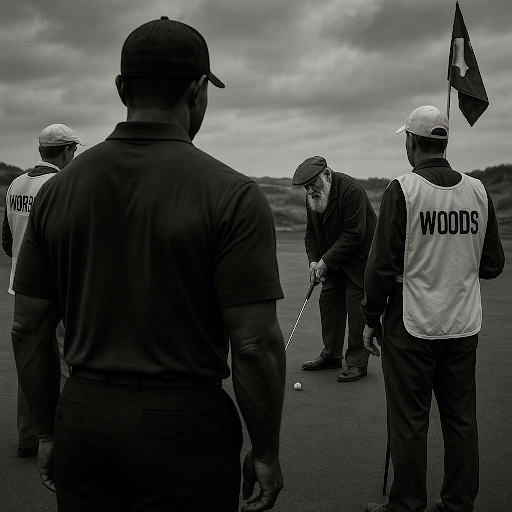Picture Old Tom Morris standing over a putt at St. Andrews in 1870. The "green" beneath his feet is barely distinguishable from the surrounding rough — a mixture of sand, natural grass, and whatever the sheep left behind. His ball is a leather pouch stuffed with boiled feathers that rolls about as true as a square wheel. His putter is a wooden club carved by the local club maker, probably his father.
Now picture a modern tour pro in a biomechanics lab, sensors attached to every joint, high-speed cameras capturing every millisecond of the stroke, computer screens displaying data that would have seemed like witchcraft to Old Tom.
The journey between these two images tells the story of putting's evolution, and reveals how far we've come in our understanding of what it takes to roll a ball into a hole.
When Putting Was Pure Survival

Feathery golf ball rendition
Early golf wasn't really about putting as we know it. Those first golfers were just trying to get their feathery balls close to holes cut randomly in natural grass. The balls themselves were the main enemy. They were hand-stitched leather that swelled in rain, deflated in heat, and rarely rolled straight even on perfect days.
Wooden putters dominated because metal was expensive and difficult to work with. Each clubmaker had his own theories about design, leading to wild variations in weight, loft, and face angle. Players adapted their techniques to their equipment rather than the other way around. Imagine learning to putt when your ball might suddenly veer left because it hit a pebble, or when your wooden putter face had warped overnight in the Scottish mist.
The Gutty Ball Changes Everything

Gutta-percha "gutty" ball rendering
When gutta-percha balls arrived in the 1840s, putting suddenly became skill-based rather than luck-based. These rubber balls rolled true, lasted longer, and cost less than featheries. For the first time, a golfer could reasonably expect the ball to go where they aimed it.
This was a philosophical revolution. The modern concept of putting — controlling both direction and distance with precision — was born with the gutty ball. Players could finally develop repeatable methods because they had reliable golf equipment to work with.
Greens Worth the Name
The late 1800s brought the first real putting surfaces. Greenkeepers discovered that certain grasses could be maintained at shorter heights, creating smoother, more predictable playing conditions. Golf course architects like Old Tom Morris himself began designing greens that challenged putting skills rather than just providing a target.
Slopes, subtle breaks, and strategic pin positions turned putting from a simple finishing touch into a crucial part of the game. The art of green reading was born during this era, though it would be decades before anyone understood the physics behind why putts broke the way they did.
Iron Putters and the Birth of Feel
 Iron putters appeared in the early 1900s, offering consistency that wooden clubs couldn't match. The weight distribution was more predictable, and the face angle more reliable. Players could finally develop equipment-specific techniques rather than adapting to whatever club they happened to own.
Iron putters appeared in the early 1900s, offering consistency that wooden clubs couldn't match. The weight distribution was more predictable, and the face angle more reliable. Players could finally develop equipment-specific techniques rather than adapting to whatever club they happened to own.
More importantly, the relationship between player and putter began to resemble what we see today. Golfers started developing preferences for specific designs, weights, and feels. The mystical connection between golfer and putter — that indefinable sense of "rightness" when you find the perfect club — was born during this era.
Science Crashes the Party
The real revolution came in the 1990s when researchers began applying serious scientific analysis to putting. High-speed cameras revealed that many fundamental assumptions about putting were wrong. Biomechanics research showed that the best putters didn't follow textbook form, but instead followed consistent personal patterns.
Dr. Dave Pelz shocked the golf world by proving that most putts miss because of poor distance control, not poor aim. His research showed that putts finishing past the hole had a 10% better chance of going in than those dying at the front edge. Suddenly, speed became more important than line, fundamentally changing how putting was taught and practiced.
The Lab Coat Era

Today's putting analysis makes Old Tom's wooden club look prehistoric. Motion capture systems track every joint. Force plates measure weight distribution. High-speed cameras reveal impact dynamics invisible to the human eye. Some tour players now know their optimal stroke tempo down to the millisecond.
But here's what fascinates me: all this technology has led us back to some ancient truths. The best putters throughout history, from Old Tom Morris to Tiger Woods, have always understood that consistency trumps perfection and that personal technique matters more than textbook form. The lab coats just gave us the data to prove what great putters always knew instinctively.
The Knowledge Trap
We now know more about putting than ever before, yet weekend golfers aren't dramatically better putters than their predecessors. Old Tom Morris never heard of "strokes gained" or "optimal launch angle," but he could read greens and control distance with remarkable skill.
I've watched modern golfers become paralyzed by their own knowledge. They know their putterface was 2.3 degrees open at impact, but they can't figure out why they missed a three-footer. Sometimes ignorance really is bliss, especially when you're standing over a putt that matters.
What Actually Changed
The evolution of putting isn't really about equipment or technique. Instead, it's about the transformation from survival skill to precision art. Early golfers putted to avoid disaster. Modern golfers putt to create an advantage.
This shift explains every innovation we've seen: better balls because precision matters, scientific surfaces because consistency is king, biomechanical analysis because marginal gains decide championships. We've moved from "just get it close" to "every putt matters," and that philosophical change has pushed all the technical evolution.
The Thread That Connects Them All
Through all the changes, ranging from equipment, surfaces, technique, and technology, one thing remains constant: the mental challenge of rolling a ball into a hole under pressure. Old Tom Morris felt the same nerves over a crucial putt that modern tour pros experience today.
That human element is why putting remains golf's great equalizer. It's why weekend golfers can occasionally putt as well as the pros, why the greatest players in history have all struggled on the greens at crucial moments, and why you can have all the technology in the world but still leave a two-footer short when it counts.
The tools have evolved dramatically, but the fundamental challenge remains beautifully, frustratingly the same. And maybe that's exactly how it should be.





